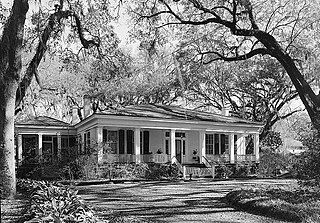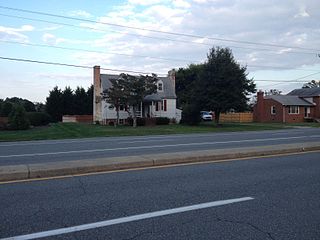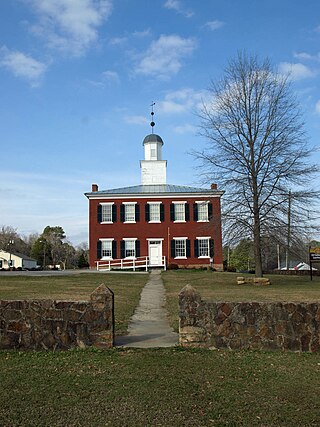This is a list of properties and historic districts in Tennessee that are listed on the National Register of Historic Places. There are over 2,000 in total. Of these, 29 are National Historic Landmarks. Each of Tennessee's 95 counties has at least one listing.

Bride's Hill, known also as Sunnybrook, is a historic house near Wheeler, Alabama. It is significant as an example of a Tidewater-type cottage built on a large slave plantation. It was added to the Alabama Register of Landmarks and Heritage on April 16, 1985, and to the National Register of Historic Places on July 9, 1986.

Creole architecture in the United States is present in buildings in Louisiana and elsewhere in the South, and also in the U.S. associated territories of Puerto Rico and the U.S. Virgin Islands. One interesting variant is Ponce Creole style.

Altwood is a historic plantation house located near Faunsdale, Alabama. It was built in 1836 by Richard H. Adams and began as a log dogtrot house. It was then expanded until it came to superficially resemble a Tidewater-type cottage. Brought to the early Alabama frontier by settlers from the Tidewater and Piedmont regions of Virginia, this vernacular house-type is usually a story-and-a-half in height, displays strict symmetry, and is characterized by prominent end chimneys flanking a steeply pitched longitudinal gable roof that is often pierced by dormer windows.
Wheeler is an unincorporated community in Lawrence County, Alabama, United States. Wheeler had a post office at one time, but it no longer exists. Wheeler has two sites on the National Register of Historic Places, the Tidewater-type cottage known as Bride's Hill and the former home of Joseph Wheeler, Pond Spring.

Fairhope Plantation is a historic Carpenter Gothic plantation house and historic district, located one mile east of Uniontown, Alabama, US. The 2+1⁄2-story wood-framed main house was built in the Gothic Revival style in the late 1850s. The plantation historic district includes six other contributing buildings, in addition to the main house. It was added to the Alabama Register of Landmarks and Heritage on December 19, 1991, and subsequently to the National Register of Historic Places on May 29, 1992, due to its architectural and historical significance.

The Denby House is a historic raised cottage in Mobile, Alabama. The one-story brick house was built by Charles Denby in 1873. It was added to the National Register of Historic Places on January 5, 1984. In addition to being listed individually on the National Register of Historic Places, it is also a contributing building to the Lower Dauphin Street Historic District.

The U. J. Cleveland House is a historic house located at 551 Charles Street in Mobile, Alabama. It is locally significant as an intact Gulf Coast Cottage with an unusual interior plan.

Georgia Cottage, also known as the Augusta Evans Wilson House, is a historic residence in Mobile, Alabama, United States. It was added to the National Register of Historic Places on September 14, 1972, based on its association with Augusta Jane Evans. She was one of the most popular American novelists of the nineteenth century and the first female author in the United States to earn over $100,000 for her work, but has been largely forgotten in recent times.

The Hawthorn House was a historic house in Mobile, Alabama, United States. The 1+1⁄2-story wood-frame structure, on a brick foundation, was built in 1853 in the Gulf Coast Cottage style by Joshua K. Hawthorn. It was placed on the National Register of Historic Places on May 21, 1984, based on its architectural significance. The house was demolished in October 2021.
This is a list of the 26 multiple property submissions on the National Register of Historic Places in Alabama. They contain more than 288 individual listings of the more than 1,200 on the National Register in the state.

Cool Well is a historic home located near Mechanicsville, Hanover County, Virginia. It was built in 1834–1835, and is a small, 1+1⁄2-story, frame Tidewater cottage in the Federal style. The house sits on a brick foundation and has a gable roof with dormers.

The McCrary House is a historic farm house near Huntsville in Madison County, Alabama. Founded after the initial federal land sale in Madison County in 1809, the farm has been in the McCrary family throughout. It was recognized as an Alabama Century & Heritage Farm in 1979, and reaffirmed on its 200th anniversary in 2009. Additionally, the house was listed on the Alabama Register of Landmarks and Heritage in 1979 and the National Register of Historic Places in 1982.
The Dr. William E. Murphey House was a historic residence near Trinity, Alabama, United States. The house was built around 1824 by George Murphey, a settler from North Carolina. The house eventually passed to his son, William. It was a Tidewater cottage with a hall and parlor layout, common in Murhpey's native North Carolina but rare in North Alabama. The house was listed on the National Register of Historic Places in 1986. It was destroyed by a tornado on April 27, 2011.

The Somerville Courthouse is a historic building in Somerville, Alabama. The oldest extant courthouse in Alabama, it was built in 1837 as the second courthouse for Morgan County. It served until 1891, when the county seat was moved to the larger Decatur. The building was later used as a school and town hall. The courthouse is two stories and constructed of brick, with large, eight-over-eight sash windows on each façade and the sides. The hipped roof is topped with an octagonal cupola with a wooden base and topped with a finial. Two interior chimneys pierce the roof on each side. The courthouse was listed on the National Register of Historic Places in 1972.
The Peter F. Armistead Sr. House is a historic residence near Florence, Alabama. The land was purchased by Peter Fontaine Armistead in 1818, with the house built around 1825. The exterior is a near copy of Armistead's home in Culpeper County, Virginia, "Glen Ella". Thomas S. Broadfoot purchased the house in 1877, who sold it to Howard Wright in 1935. The house underwent restoration in the 1970s. The house is five bays wide, with steps leading up to a narrow, flat-roofed entry portico. There are three dormer windows protruding from the gable roof on the front and rear. The interior is laid out in a double-pile configuration, with a parlor behind the front stair hall. A kitchen wing was added to the northwest rear in the 1970s. The house was listed on the Alabama Register of Landmarks and Heritage in 1978 and the National Register of Historic Places in 1986.

The George Coulter House is a historic house located at 420 South Pine Street in Florence, Alabama.
The William Koger House is a historic residence near Smithsonia, Alabama. The house was built around 1830 by William and Martha Koger, planters from Virginia. The Kogers brought their native architectural form, the Tidewater-type cottage, with them to North Alabama. The house was the center of a 630-acre (255-ha) plantation, which included an island in the Tennessee River. After William's death, Martha continued to manage the farm until her death in 1892.
The John Johnson House also known as The Green Onion is a historic residence near Leighton, Alabama, USA. The house was built in the late 1820s by John Johnson, a settler from Mecklenburg County, Virginia, who lived in Middle Tennessee before coming to North Alabama. His son-in-law, Lewis Dillahunty, was one of the earliest settlers in the western Tennessee Valley, and convinced Johnson to move to the area. Johnson died in the early 1840s, and his son sold the house and 80 acres out of the family. The house has been long occupied by tenant farmers, and is now part of the Leonard Preuitt estate.
















